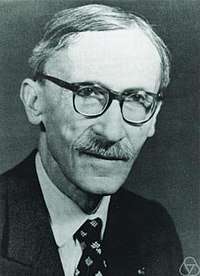Paul Lévy (mathematician)
Paul Pierre Lévy (15 September 1886 – 15 December 1971)[2] was a French mathematician who was active especially in probability theory, introducing fundamental concepts such as local time, stable distributions and characteristic functions. Lévy processes, Lévy flights, Lévy measures, Lévy's constant, the Lévy distribution, the Lévy area, the Lévy arcsine law, and the fractal Lévy C curve are named after him.
Paul Lévy | |
|---|---|
 Paul Pierre Lévy | |
| Born | 15 September 1886 |
| Died | 15 December 1971 (aged 85) |
| Nationality | French |
| Alma mater | University of Paris |
| Known for | Study of fine properties of Brownian motion Local time Lévy flight Lévy measure Lévy's constant Lévy distribution Lévy C curve |
| Awards | Emile Picard Medal of the French Academy of Sciences (1953)[1] |
| Scientific career | |
| Fields | Mathematics |
| Institutions | École Polytechnique École des Mines |
| Doctoral advisor | Jacques Hadamard Vito Volterra |
| Doctoral students | Wolfgang Doeblin Michel Loève Benoît Mandelbrot Georges Matheron |
Biography
Lévy was born in Paris to a Jewish family which already included several mathematicians.[3] His father Lucien Lévy was an examiner at the École Polytechnique. Lévy attended the École Polytechnique and published his first paper in 1905, at the age of nineteen, while still an undergraduate, in which he introduced the Lévy–Steinitz theorem. His teacher and advisor was Jacques Hadamard. After graduation, he spent a year in military service and then studied for three years at the École des Mines, where he became a professor in 1913.[2]
During World War I Lévy conducted mathematical analysis work for the French Artillery. In 1920 he was appointed Professor of Analysis at the École Polytechnique, where his students included Benoît Mandelbrot and Georges Matheron. He remained at the École Polytechnique until his retirement in 1959, with a gap during World War II after his 1940 firing because of the Vichy Statute on Jews.[2]
Lévy made many fundamental contributions to probability theory and the nascent theory of stochastic processes. He introduced the notion of 'stable distribution' which share the property of stability under addition of independent variables and proved a general version of the Central Limit theorem, recorded in his 1937 book Théorie de l'addition des variables aléatoires, using the notion of characteristic function. He also introduced, independently from Ya. Khinchine, the notion of infinitely divisible law and derived their characterization through the Lévy–Khintchine representation.
His 1948 monograph on Brownian motion, Processus stochastiques et mouvement brownien, contains a wealth of new concepts and results, including the Lévy area, the Lévy arcsine law the local time of a Brownian path and many other results.
Lévy received a number of honours, including membership at the French Academy of Sciences and honorary membership at the London Mathematical Society.
His daughter Marie-Hélène Schwartz and son-in-law Laurent Schwartz were also notable mathematicians.[4]
Works
- 1922 – Lecons d'analyse Fonctionnelle
- 1925 – Calcul des probabilités
- 1937 – Théorie de l'addition des variables aléatoires
- 1948 – Processus stochastiques et mouvement brownien
- 1954 – Le mouvement brownien
See also
- Lévy distribution
- Lévy metric
- Lévy's modulus of continuity
- Lévy–Prokhorov metric
- Lévy's continuity theorem
- Lévy's zero-one law
- Concentration of measure
- Lévy process
- Lévy–Khintchine representation
- Lévy–Itô decomposition
- Lévy flight
- local time
- Lévy's characterisation of Brownian motion
References
- Médaille Emile Picard
- O'Connor, John J.; Robertson, Edmund F., "Paul Lévy (mathematician)", MacTutor History of Mathematics archive, University of St Andrews.
- Barbut, Marc; Locker, Bernard; Mazliak, Laurent (2013). Paul Lévy and Maurice Fréchet: 50 Years of Correspondence in 107 Letters. p. xii. ISBN 978-1-4471-5618-5.
- Kosmann-Schwarzbach, Yvette (2015), "Women mathematicians in France in the mid-twentieth century", BSHM Bulletin: Journal of the British Society for the History of Mathematics, arXiv:1502.07597, doi:10.1080/17498430.2014.976804.
External links
- Rama Cont: Paul Lévy: a biography
- Gérard P. Michon: Paul Lévy and Functional Analysis
- Paul Lévy at the Mathematics Genealogy Project
- O'Connor, John J.; Robertson, Edmund F., "Paul Lévy (mathematician)", MacTutor History of Mathematics archive, University of St Andrews.